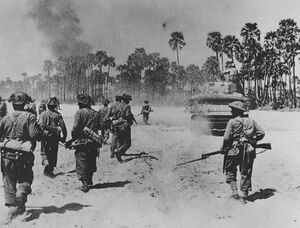Operation Arbiter
This article is incomplete because it is pending further input from participants, or it is a work-in-progress by one author. Please comment on this article's talk page to share your input, comments and questions. Note: To contribute to this article, you may need to seek help from the author(s) of this page. |
Operation Arbiter or the 1944 Winter Invasion of Quenmin (19 Decemeber 1944 - 20 January 1945) was the codename for the Allied invasion of Quenmin. As part of the plans for December, Allied forces attempted to isolate Imperial forces near the Quenminese-Bethausian border. On 10 December, Sugiyama managed to split the Imperial flanks in two at the Battle of Amyu, therefore isolating the Ramuncian Army from the Quenminese and Archadian Armies to the north. The Ramuncians were forced to fall back to the Port of Pyataza and the small city of Paungwei. While a part of the Allied forces engaged with the isolated Ramuncian Army at the Paungwei Pocket, General Archibald Sugiyama took the opportunity of invading Quenmin.
On the night of 19 December, Sugiyama launched a savage artillery attack on the Quenminese border, where he attempted to break the Emperor Hiep Mang Line. When the morning had arrived, Allied forces attacked on all sides. By 3:00pm, the line had been breached, allowing Sugiyama to concentrate attacks on the Central flank and enable Commonwealth forces to flow into Quenmin for the first time.
Estharian troops under Generalissimo A.C.G. Lindholm along with Dalmascan and Galbadian troops arrived late on Christmas Day and engaged with the Quenminese Northern flank at the Battle of Hai Giá. Chien attempted to lure the Allied forces into a trap which would see Archadian Forces and the Quenminese Forces in the North and South to encircle and cut off part of the 11th Army. On New Year's Day, Chien placed his plan into action but the Estharians under Franco continued to give chase to the Northern Quenminese Army under General Kiều Dũng Quang, which prompted Chien to divert all Quenminese troops in the North, leaving the Central and Southern flank to engage with the Commonwealth armies.
Chien's strategy had backfired, prompting him to ruthlessly send every Imperial forces against the Commonwealth and Estharian forces. Despite it, Sugiyama and Franco remained vigilant. Sugiyama depended on the Allied forces still in Bethausia to reinforce them. On 11 January, Brigadier Tsukuyo Kushineda, along with Generals Regnitz, Testaross, and Arkar crossed the border and engaged with the southern flank, thereby allowing Allied forces to gain the upper hand and defeat them at the Battle of Cao Nhon. After being talked out by his Generals, Marshal Chiến ordered a retreat.
The operation marked the first time that Quenmin had been invaded by the Allied forces. Sugiyama's invasion force held the distinct honour of being able to successfully breach an Imperial border and gave Sugiyama a hero's status throughout the Lucis Army. After the battle, Chiến sacked and executed many officers after realizing that Quenmin had been invaded for the first time.
